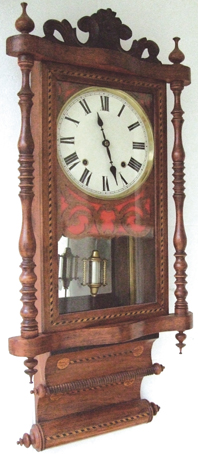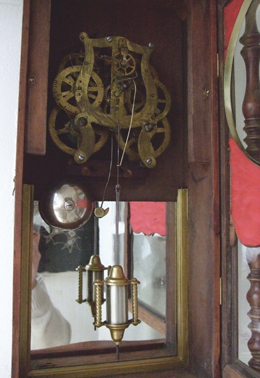Caledonian and kinetic

 Further to the article by Peter Gosnell in the November 2007 issue of Clocks concerning ‘The Caledonian Registered’ and referring to Chas Cartwright and Sons, I have a clock which is identical to the clock photographed in this article. I assumed from the case and movement that my clock was American from the mid 1800s.
Further to the article by Peter Gosnell in the November 2007 issue of Clocks concerning ‘The Caledonian Registered’ and referring to Chas Cartwright and Sons, I have a clock which is identical to the clock photographed in this article. I assumed from the case and movement that my clock was American from the mid 1800s.
I found the clock in an antique shop which was closing down and bought it for a reasonable price. It was in a sorry state but was complete except for the finials on the sides of the lower trunk for which a friend of mine made replacements. I don’t know if they are correct but they look OK to me. I stripped and cleaned the movement but didn’t polish the parts. Some of the escape wheel teeth were bent. These were straightened but when the movement was trial run it was apparent that the teeth were not concentric with the pivots.
The concentricity of the arbor to the pivots was checked and found to be good so I put the arbor into the lathe with the escape wheel hard up to the chuck jaws. I then attached a fine emery faced nail-file to the back face of the lathe cross-tool holder. With the lathe running relatively slowly the cross slide was wound towards the revolving teeth. As the file touched the teeth the eccentricity became apparent from the intermittent noise. By gradually adjusting the cross slide towards the escape wheel the eccentricity was removed. The movement was re-assembled and with a slight adjustment of the pallet pivot position—easy with this type of clock—the movement performed well with a good regular beat.
I was pleased to read Bill Morris’s article concerning kinetic energy correcting Barry Fitton’s remarks on this subject. The dissipation of kinetic energy in clocks is interesting and could be considered to have a significant contribution to the wear rate of pivots and teeth as all the wheels are stopping and starting all the time because of the action of the escapement or the striking gear train.
The formula for calculating kinetic energy is
KE = 1/2MV2
where M = Mass and V = velocity. This is relatively simple for objects moving in a straight line but for revolving objects it is more difficult and I am not prepared to begin explaining it here. Nevertheless as can be seen from the equation the kinetic energy is dependent on the velocity; if there is no velocity of the gear train then there is no kinetic energy.
I find Clocks magazine very interesting and look forward every month to receiving it.
Roger Pedley, Dorset, UK
|

